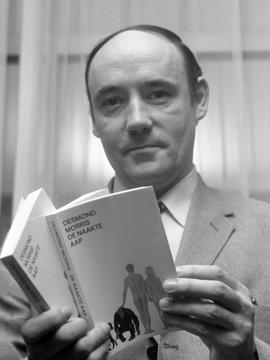Desmond John Morris is an English zoologist, ethologist and surrealist painter, as well as an author in human sociobiology. He is known for his 1967 book 'The Naked Ape' and for his television programmes such as 'Zoo TIme'.
Morris was born in Purton, Wiltshire, to Marjorie (nee Hunt) and children's fiction author Harry Morris. He was educated at Dauntsey's School, Wiltshire. In 1946 he joined the British Army for two years of national service, becoming a lecturer in fine arts at the Chiseldon Army College in Wiltshire. After being demobilised he studied zoology at the University of Birmingham. In 1951 he began a doctorate at the Department of Zoology, University of Oxford, in animal behaviour. In 1954 he earned a Doctor of Philosophy for his work on the reproductive behaviour of the ten-spined stickleback.
In 1956 he moved to London as Head of the Granada TV and Film Unit for the Zoological Society of London, and studies the picture-making abilities of apes. The work included creating programmes for film and television on animal behaviour and other zoology topics. He hosted Granada TV's weekly 'Zoo Time' programme until 1959, and 'Life in the Animal World' for BBC2. In 1957 he organised an exhibition at the Institute of Contemporary Arts in London, showing paintings and drawings composed by common chimpanzees. In 1958 he co-organised an exhibition, 'The Lost Image', which compared pictures by infants, human adults and apes, at the Royal Festival Hall, London. In 1959 he left 'Zoo Time' to become the Zoological Society of London's Curator of Mammals. In 1964 he delivered the Royal Institution Christmas Lecture on Animal Behaviour. In 1967 he spent a year as Executive Director of the London Institute of Contemporary Arts.
Morris's books include 'The Naked Ape: A Zoologist's Study of the Human Animal' (1967). Morris moved to Malta in 1968 to write a sequel and other books. In 1973 he returned to Oxford to work for the ethologist Niko Tinbergen. From 1973 to 1981, Morris was a Research Fellow at Wolfson College, Oxford. In 1979 he undertook a television series for Thames TV, 'The Human Race', followed in 1982 by 'Man Watching in Japan, The Animals Road Show' in 1986 and then several other series. National Life Stories conducted an oral history interview (C1672/16) with Morris in 2015 for its Science and Religion collection held by the British Library.
